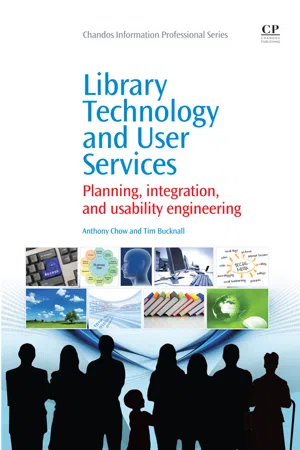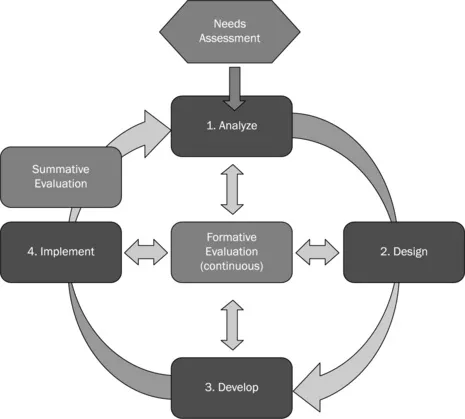
eBook - ePub
Library Technology and User Services
Planning, Integration, and Usability Engineering
- 170 pages
- English
- ePUB (mobile friendly)
- Available on iOS & Android
eBook - ePub
Library Technology and User Services
Planning, Integration, and Usability Engineering
About this book
Written as a technology guide for students, practitioners, and administrators, the focus of this book is on introducing current and future trends in library technology and automation within the larger context of strategic and systems planning, implementation, and continuous improvement. Technology is an essential resource for attaining both organizational and patron goals, and planning needs to emphasize the alignment between the clearly defined goals of each. For this alignment to occur on a consistent basis goals must be designed, or engineered, in a systematic fashion where technology fulfils the need to deliver the desired outcomes in an efficient, cost-effective manner. The concept of usability engineering is also examined, where the technology is planned, designed, and implemented in such a way as to maximize utility and ease-of-use for users and employees. Readers of this book will understand both the why and the how of library technology, planning, and implementation articulated in a simple, easy-to-understand fashion.
- Delivered from academic, public, and school library media perspectives
- Current and emerging technologies are discussed along with their current and future application in the field of library and information science
- Technology planning and integration is explained using a systems design process with scenarios and case studies that are articulated in a step-wise, holistic fashion
Frequently asked questions
Yes, you can cancel anytime from the Subscription tab in your account settings on the Perlego website. Your subscription will stay active until the end of your current billing period. Learn how to cancel your subscription.
At the moment all of our mobile-responsive ePub books are available to download via the app. Most of our PDFs are also available to download and we're working on making the final remaining ones downloadable now. Learn more here.
Perlego offers two plans: Essential and Complete
- Essential is ideal for learners and professionals who enjoy exploring a wide range of subjects. Access the Essential Library with 800,000+ trusted titles and best-sellers across business, personal growth, and the humanities. Includes unlimited reading time and Standard Read Aloud voice.
- Complete: Perfect for advanced learners and researchers needing full, unrestricted access. Unlock 1.4M+ books across hundreds of subjects, including academic and specialized titles. The Complete Plan also includes advanced features like Premium Read Aloud and Research Assistant.
We are an online textbook subscription service, where you can get access to an entire online library for less than the price of a single book per month. With over 1 million books across 1000+ topics, we’ve got you covered! Learn more here.
Look out for the read-aloud symbol on your next book to see if you can listen to it. The read-aloud tool reads text aloud for you, highlighting the text as it is being read. You can pause it, speed it up and slow it down. Learn more here.
Yes! You can use the Perlego app on both iOS or Android devices to read anytime, anywhere — even offline. Perfect for commutes or when you’re on the go.
Please note we cannot support devices running on iOS 13 and Android 7 or earlier. Learn more about using the app.
Please note we cannot support devices running on iOS 13 and Android 7 or earlier. Learn more about using the app.
Yes, you can access Library Technology and User Services by Anthony S. Chow,Tim Bucknall in PDF and/or ePUB format, as well as other popular books in Langues et linguistique & Bibliothèques et sciences de l'information. We have over one million books available in our catalogue for you to explore.
Information
eBook ISBN
97817806329021
Stone tablets, paper and the Internet: the same old library?
Abstract:
Libraries have been serving users since antiquity but their purpose remains relatively unchanged – they serve the information needs of people. This chapter discusses how technology has enhanced the way libraries do what they have always done: but bigger, better and faster. Contemporary national trends of public, academic and school libraries in the US are summarized. The science of systems thinking is introduced and posited as a fundamental way in which to meet the basic information-seeking needs of people in a systematic way, and provide well-aligned resources and services that form the foundation of user services excellence.
Key words
Libraries
Technology
Trends
user services
systems thinking
ADDIE model
information seeking
organizations
performance technology
Libraries 2.0
public
academic
school.
Libraries 2.0
Libraries are undergoing a period of incredibly rapid change. Although they continue to serve their traditional societal purpose, new technologies are allowing us to serve that purpose in bigger, better and faster ways. The genesis of the library as an intellectual repository can perhaps be traced back 32,000 years ago to when the paintings of our ancestors were created in uninhabited caves (Clottes, 2003). In ancient Mesopotamia some 5,000 years ago, thousands of clay tablets were gathered and stored in a central location and one of history’s first great libraries was built in Greek Alexandria around 300 BC to house hundreds of thousands of papyrus and parchment rolls (Krasner-Khait, 2001).
In many important ways, libraries are the same as they have ever been. Growing up in the 1970s, both of us (the authors) loved going to our local libraries to spend hours exploring the stacks and using the world of books to temporarily escape the sweltering summer days of the American South. We remember comfortable chairs, bean bags, a vibrant library community and innumerable books just waiting to be discovered. Today, in 2011, we both now bring our own children to our local public libraries to do the exact same thing. The library as a safe place, a bastion of knowledge and a portal to other worlds remains unchanged. However, the transactions and efficiency, through which this takes place, have changed substantially.
As children in the 1970s we did not have personal computers or the Internet. Today, we take these tools almost for granted. Our children do not have to search a physical library catalog filled with three-by-five-inch paper index cards. In fact, they do not even have to leave home in order to peruse the holdings of our local libraries. With the online catalog, books that are already checked out are clearly marked and our children can get suggested reading lists or book reviews. Today, when we arrive at the library there are typically anywhere from 20 to 30 books waiting for us on hold at the front desk; although we still explore the stacks, most of the transaction has already taken place in an extremely effective and efficient manner.
The online environment in which our children can interact with the library changes the game. Our ability to search our public library’s holdings from the comfort of our own home is both raising and shaping our children’s expectations of future library services. A nationwide study of public libraries in the United States found that:




According to one library administrator, ‘We are not being used less; we are being used differently’ (Clark and Davis, 2009: 17).
Technology integration and user services
If people cannot or will not use a feature, it might as well not exist. (Nielsen and Loranger, 2006: xvi)
The central principles of usability and user-centered design are that a product or service must be high in utility and ease-of-use for the user (Nielsen, 2003). Technology is a fundamental tool for nurturing, building and delivering on this promise to users. But before we can effectively implement new technologies, we must first ascertain the needs and expectations of a typically diverse library user population.
While the expectations differ widely depending on type of library, the major components to a sound technology infrastructure can be simplified into answering one simple question – ‘how strong and appropriate is your hardware and software for both your employees and the patrons?’ Of course, ‘strong’ and ‘appropriate’ are subjective terms that can be answered only by your specific context. But the point is that your hardware technology infrastructure determines your capacity for delivering all other services that requires technology – and in today’s wired libraries, that means virtually all of your services. Without a robust, or at least adequate, hardware infrastructure the software applications your organization needs, no matter how wonderful, will not function properly.
How does a library determine an appropriate array of information technology services and infrastructure? This book seeks to answer that question. Each semester we ask our management students, ‘Which comes first, ends or means?’ The answer is that ends must come first and drive the means. Librarians must use their stated ends to leverage a budget that will rarely, if ever, be as much as they need and want. Careful planning aligned to clearly identified goals is critical. Let us take a look at how to systematically plan and allocate resources accordingly.
Systems thinking and performance technology
How can you know when you have arrived, if you have no idea where you are going? (Keller, 2000)
The underpinning process behind systems thinking is the ADDIE model, which stands for Analyse, Design, Develop, Implement and Evaluate (Clark, 2010). Utilizing this process in a formal, disciplined fashion became known as performance technology because it details an easy to understand, systematic way of achieving goals in an efficient and effective manner. Two of the pioneers of this field are close friends and colleagues, Joe Harless and Roger Kaufman. Dr Harless (1970) developed the concept of Front-End Analysis (FEA), which placed the starting point at the Analyse phase of the ADDIE model. Analysis of the context, goals, constraints, resources, etc. must be identified and accounted for before any proper planning could occur. Dr Kaufman (1979), however, felt that prior to analysis, one must begin at the end of the ADDIE process and evaluate current conditions through a formal needs assessment. In 2006, Dr. Harless finally ended this debate, which had stretched over decades, by conceding that a formal needs assessment needed to be conducted prior to analysis taking place. Figure 1.1 (Barrett, 2000) illustrates the cyclic nature of the ADDIE process.

Figure 1.1 ADDIE model
Figure 1.2 (NOAA, 2010) shows the needs assessment as well as a more detailed breakdown of evaluation into formative (continuous, during all phases and process oriented) and summative (after implementation, output and outcome based).

Figure 1.2 ADDIE model with needs assessment
We will describe how this process works within the library setting in more detail in later chapters.
Library trends
The types of information services libraries are providing are evolving and expanding. According to an American Library Association (ALA) report, ‘hard times bring libraries’ value into sharper focus as the recession that t...
Table of contents
- Cover image
- Title page
- Table of Contents
- Copyright
- Dedication
- List of figures and tables
- Acknowledgements
- Foreword
- About the authors
- Introduction
- Chapter 1: Stone tablets, paper and the Internet: the same old library?
- Chapter 2: Strategic planning, organizational goals and technology: what and for whom?
- Chapter 3: Customized fashion: finding the right fit
- Chapter 4: Technology and budgeting
- Chapter 5: Evaluation: is technology meeting the needs of the organization’s users?
- Chapter 6: Emerging technology trends in libraries
- Conclusion: user needs and library technology
- References
- Index